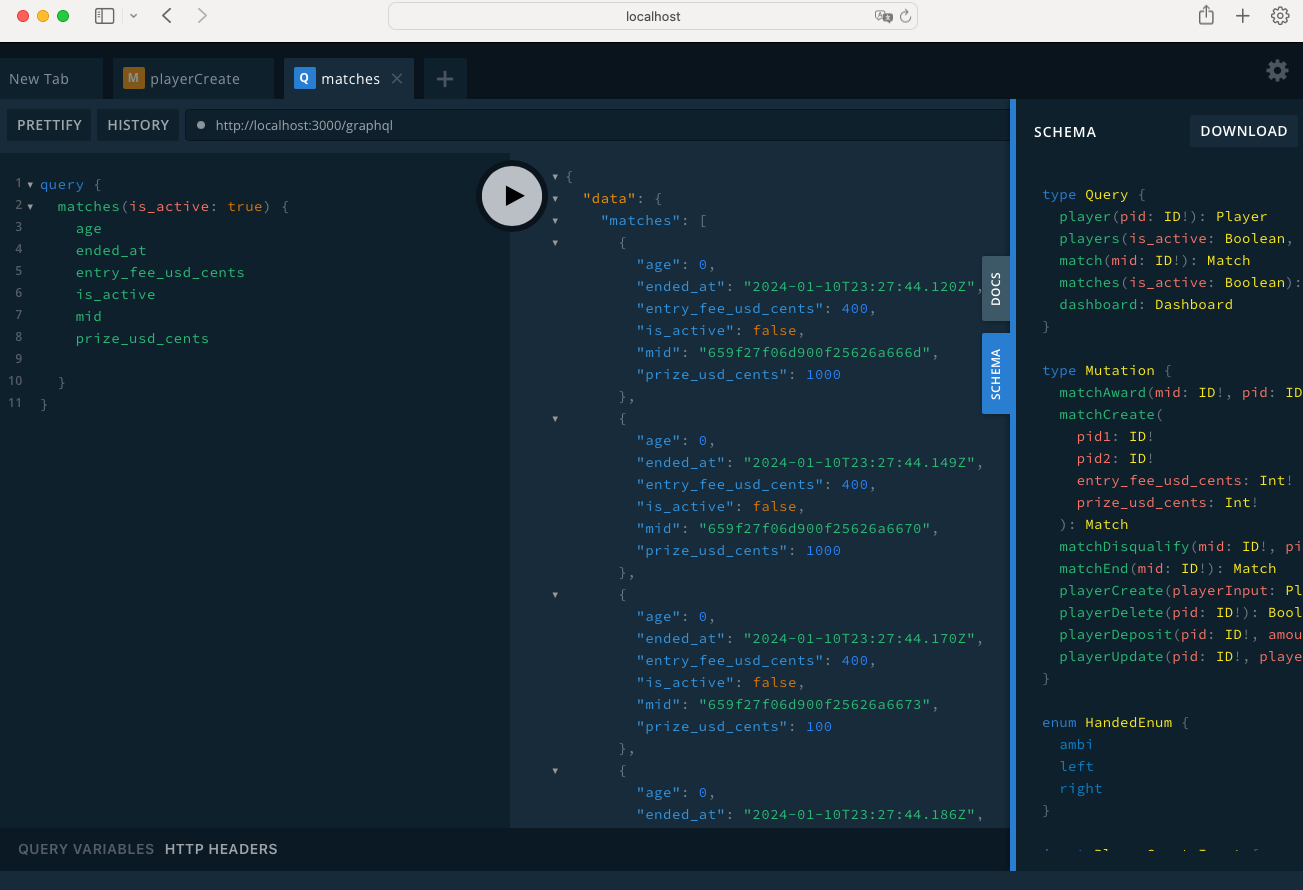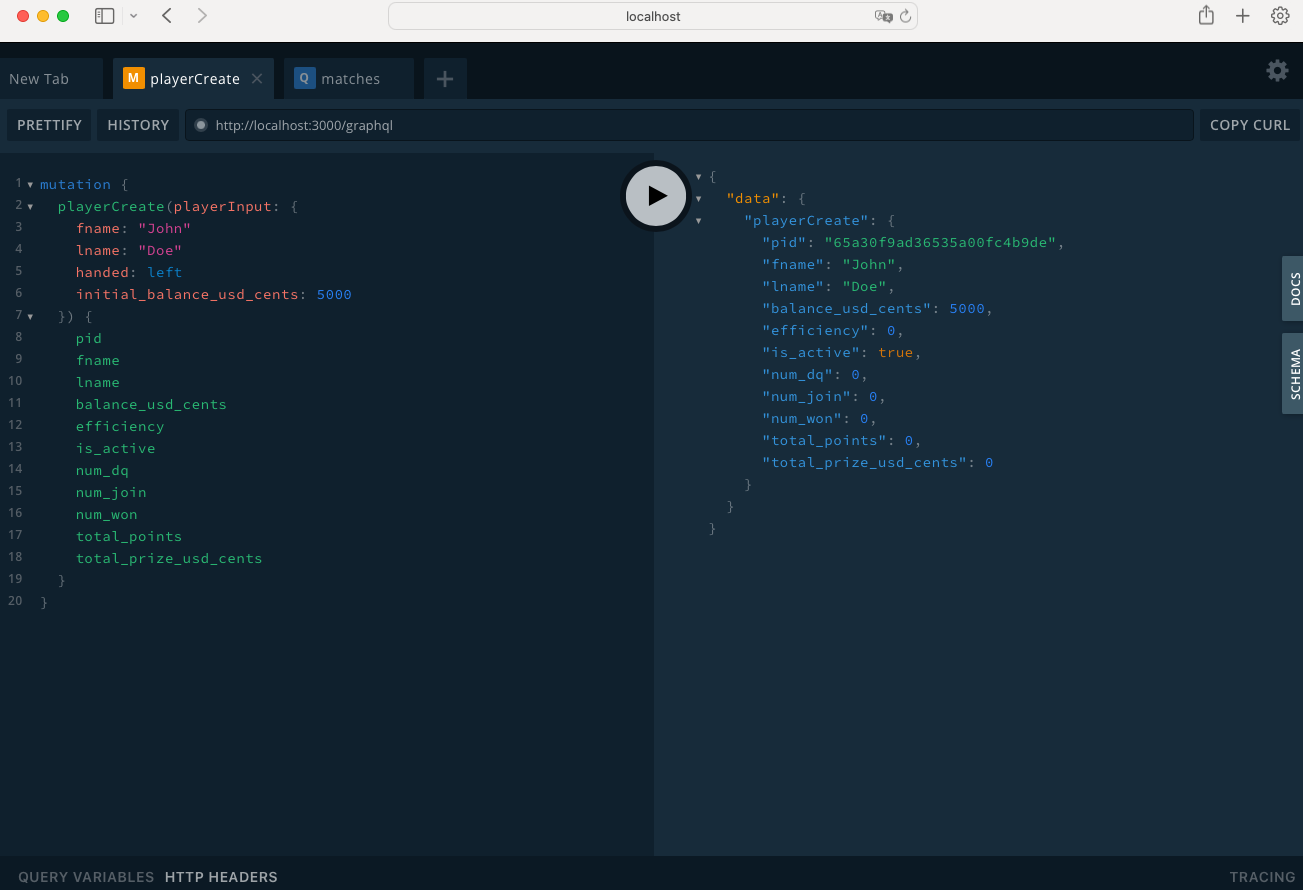Building a GraphQL HTTP server with Express and MongoDB
GraphQL has become a popular choice for building APIs due to its flexibility and efficiency in data retrieval. In this post, we’ll explore a GraphQL server implemented using Express, backed by a MongoDB database. Specifically, we’ll create a robust API to manage players and matches for a hypothetical gaming platform.
Check this code link: https://github.com/ngcxy/GraphQL-HTTP-Express
(Source: adapted from several assignments of source USC EE547)
Background
We choose Express.js Framework to set up our API endpoints, and MongoDB to store our data.
The setup for Express.js is as follows, in which we initialize an instance of Express.js as app:
const express = require('express');
const PORT = 3000;
const app = express();
app.use(express.json());
app.use(express.urlencoded({ extended: true }));
app.use(express.static("public"));
The setup for MongoDB is as follows, in which we import the mongodb and the config file (it’s ok if there’s no config file):
const { MongoClient, ObjectId} = require("mongodb");
const MONGO_CONFIG_FILE = `./config/mongo.json`;
Main Operations
In the SourceMongo class lie main operations for “players” and “matches” in the database.
Before assigning the functions, the first thing we need to do is to config our database.
constructor(FILEPATH){
try{
this.config = require(FILEPATH);
}
catch{
this.config = {
"host":"localhost",
"port":"27017",
"db":"dbname",
"opts":{
"useUnifiedTopology":true
}
}
}
const uri = `mongodb://${this.config.host}:${this.config.port}`;
const client = new MongoClient(uri, this.config.opts);
try {
const database = client.db("dbname");
this._db = database;
const player = database.collection("player");
const match = database.collection("match");
} catch (err) {
process.exit(5);
}
};
Then we are able to create operations including:
- createPlayer
- getPlayers/getPlayer
- getPlayerMatchInfo
- updatePlayer
- deletePlayer
- createMatch
- getMatches/getMatche
- dqPlayer(disqualify a player in the match)
- awardPlayer
- endMatch
You can view these functions in the code through the link.
* More classes: Validator, Error, and Decorator
These are the additional classes that help keep our code more organized - understandable manageable. Validator is used to validate the value of the input. Error serves to give specific feedback about what error takes place. Decorator rearrange the information into the object with form we expect.
By separating these classes, we’re able to reuse several functions and modify quickly in our code.
GraphQL Implementation
In GraphQL, the building blocks of your API are defined using three key concepts: typeDefs (type definitions),resolvers, and schema.
typeDefs
Type definitions define the data types available in the GraphQL API. They include object types, input types, enums, queries, mutations, and other elements. In Express.js, it is a string containing the GraphQL schema.
Our typeDefs contains two main part:
type Query {
# operations for query, with required params and return type
# for example
players(
limit: Int
offset: Int
sort: String
is_active: Boolean
q: String
): [Player]!
}
type Mutation {
# operations for mutation, with required params and return type
# for example
matchCreate(
pid1: ID!
pid2: ID!
entry_fee_usd_cents: Int!
prize_usd_cents: Int!
): Match
}
and other necessary elements:
- type Player, type Match
- some inputs with type
- types for additional use, e.g., dashboard
resolvers
Resolvers take the responsibility to actually handle the queries and mutations - they are functions that interact with our database operations. Each field in the schema has a corresponding resolver function that determines how to retrieve or calculate the data.
The resolvers are created like this:
const resolvers = {
Mutation: {
playerCreate: async (obj, { playerInput }, DB) => {
const b = playerInput;
let error = e.error_post_player(b.fname, b.lname, b.handed, b.initial_balance_usd_cents);
if (error.length === 0) {
const player = await db.createPlayer(b.fname, b.lname, handedURL2Data[b.handed], true, b.initial_balance_usd_cents);
return player;
} else {
e.error_print(error);
throw new Error();
}
},
playerUpdate: async (obj, { pid, playerInput }, DB) => {
let is_active = d.deco_is_active(playerInput.is_active);
let lname = playerInput.lname ?? null;
return db.updatePlayer(pid, lname, is_active, null);
},
// other mutations...
},
Query: {
player: async ({}, { pid }, DB) => {
return await DB.getPlayer(pid);
},
players: async ({}, { is_active, q }, DB) => {
if (q !== undefined) {
let name = decodeURIComponent(q.split(";")[0]);
var vars = q.split(";")[1] || "fname,lname";
return await DB.getNamePlayers(name, vars);
}
if (is_active == undefined || is_active == "*") {
return await DB.getPlayers();
} else {
return DB.getSomePlayers(is_active);
}
},
// other queries for match...
},
};
Schema
When under Express.js framework, the makeExecutableSchema function from the @graphql-tools/schema library is used to combine typeDefs and resolvers into a GraphQL schema:
const schema = makeExecutableSchema({
resolvers,
resolverValidationOptions: {
requireResolversForAllFields: "warn",
requireResolversToMatchSchema: "warn",
},
typeDefs,
});
Now, we successfully generate our schema, which is the overarching structure of the API.
Finally, we need to create the endpoint for graphQL. I also implement the GraphQL playground for Express.js, which is an interactive environment to where you can play around with GraphQL.
app.all('/graphql', createHandler({ schema }));
app.get('/playground', expressPlayground({ endpoint: '/graphql' }));
app.get("/ping", (req, res) => {
res.sendStatus(204);
});
app.listen(PORT);
After you start the server, you can find your API running on http://localhost:3000/graphql, and playground available on http://localhost:3000/playground


Enjoy Reading This Article?
Here are some more articles you might like to read next: